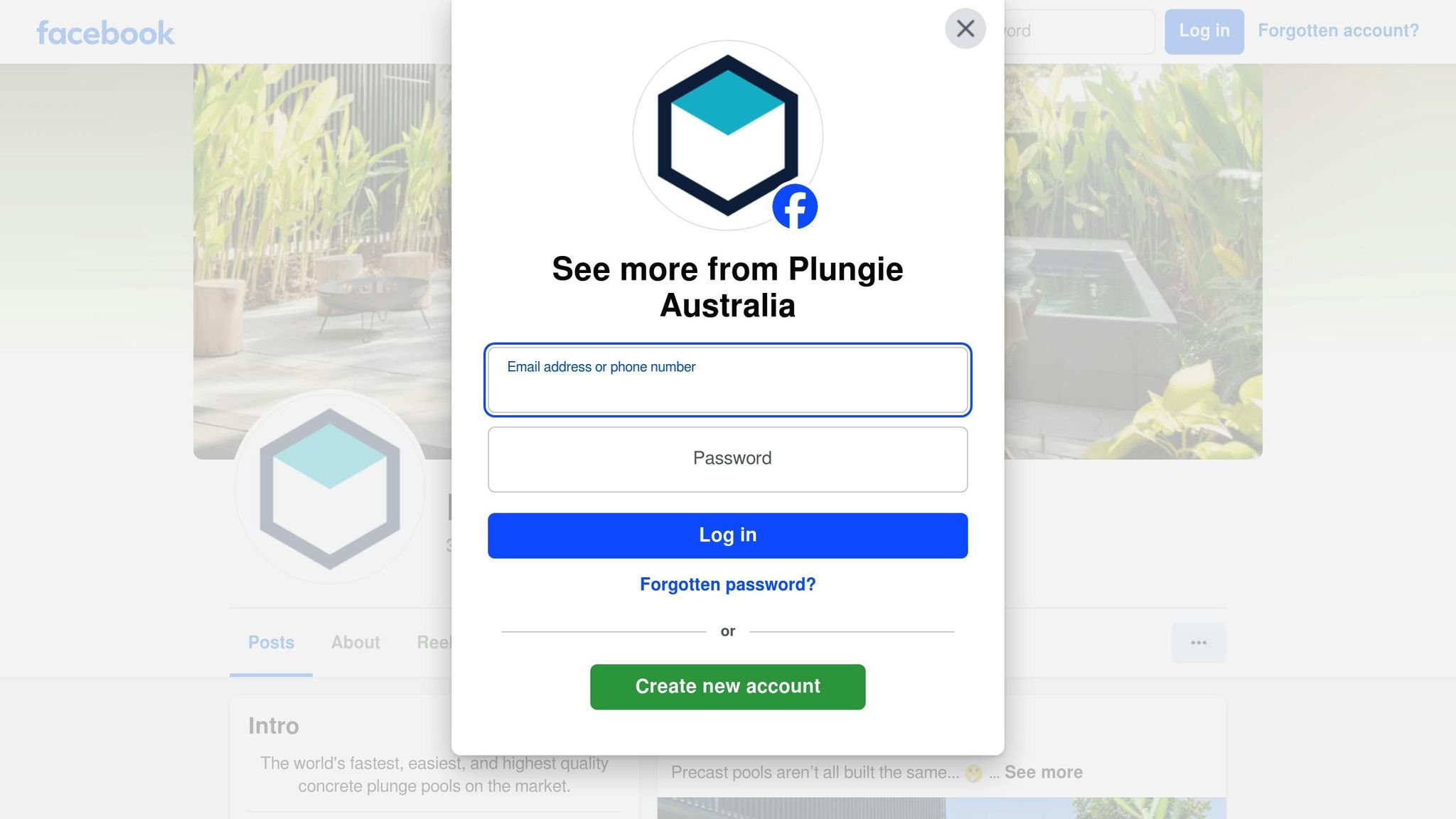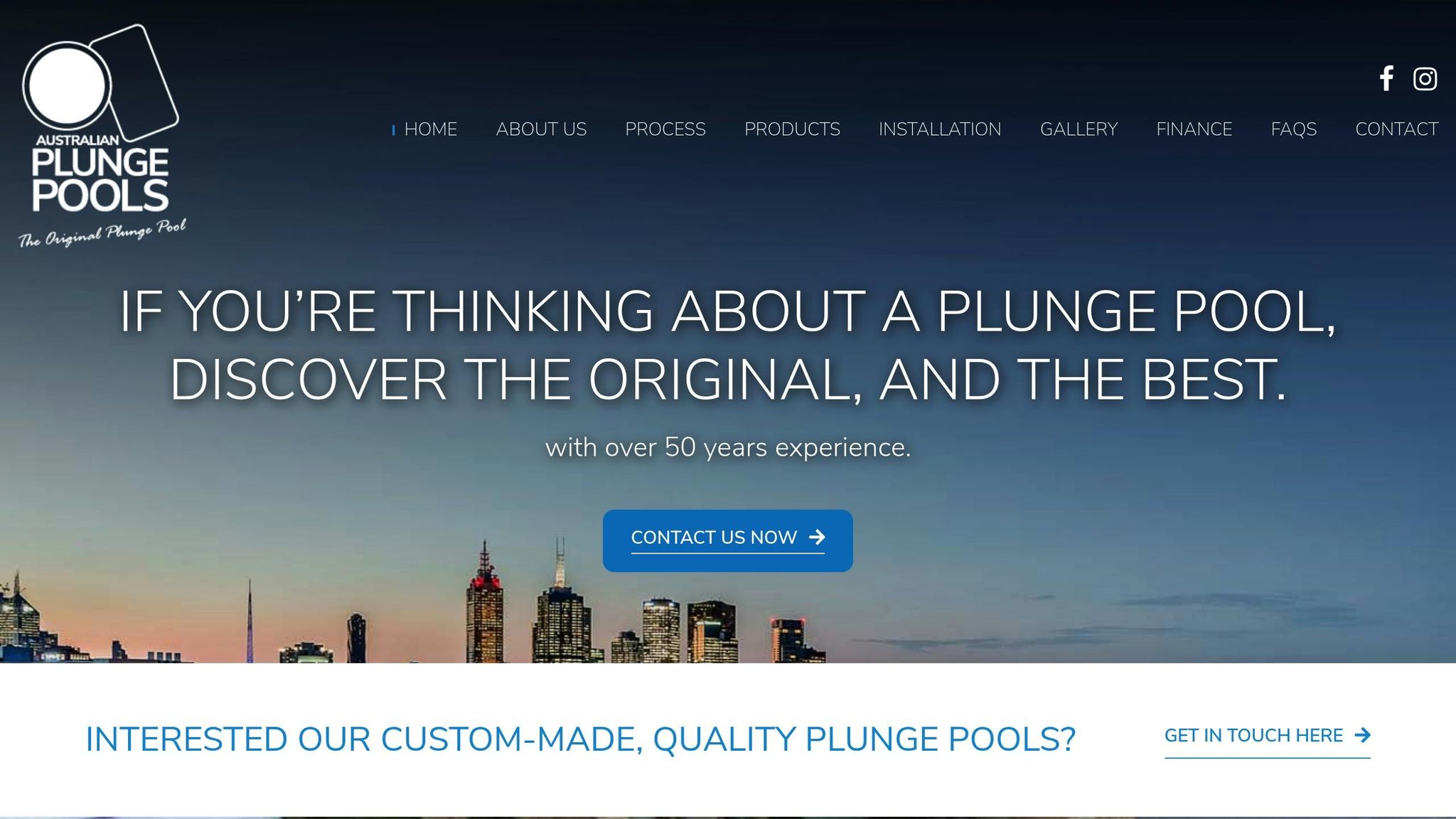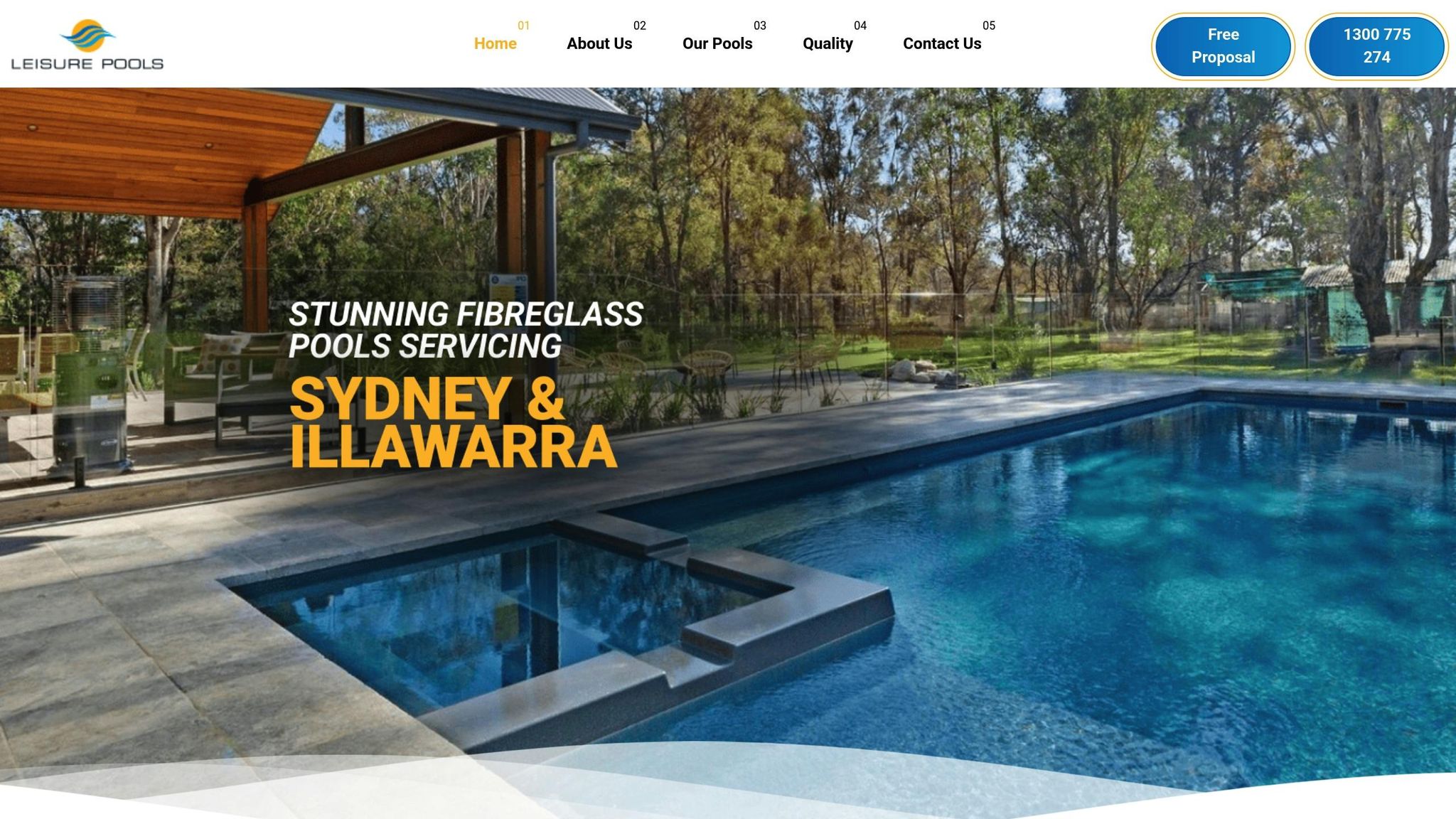
5 Stunning Plunge Pool Designs for Your Backyard
Explore diverse plunge pool designs that fit any Australian backyard, from budget-friendly options to custom creations, perfect for summer relaxation.
Last Updated:
Oct 18, 2025
Plunge pools are a great option for Australian backyards, offering a compact way to cool off during summer without needing a large space or extensive installation. They’re available in a range of styles and budgets, from affordable stock-tank pools to custom concrete designs. Here’s a quick look at five popular options:
Plungie Original: A concrete pool with flexible installation (in-ground, above-ground, or semi-recessed). Prices range from $14,990 (pool shell) to $40,000+ for full installation.
Plungie Arena: A round concrete pool that’s simple to install and comes in a variety of finishes.
Australian Plunge Pools' Custom Designs: Tailored concrete pools designed to suit unique spaces and styles.
Fibreglass Pools by Leisure Pools: Pre-made, quick-to-install pools that are low-maintenance and durable.
Stock-Tank Pools: Budget-friendly options starting at $800, using galvanised steel tanks for a simple cooling solution.
Each type caters to different needs, from quick setups to fully customised designs. Whether you’re working with a small courtyard or a larger space, there’s a pool to suit your budget and lifestyle.
Plunge Pool Perfection: Top 300+ Stunning Ideas for Every Type of Yard
1. The Plungie Original Concrete Plunge Pool

The Plungie Original is a mid-sized concrete plunge pool that combines practicality with a touch of elegance. With external dimensions of 4.6m x 2.5m, it holds 14,000 litres of water and features 2.2 square metres of built-in bench space - perfect for lounging or hosting friends. Its installation options make it a standout choice for various settings.
One of its key features is the flexible installation options. You can choose an in-ground setup for a seamless look, above-ground for minimal excavation, or a semi-in-ground installation to create a striking visual statement.
Tailor the pool’s look to your preferences. The interior finish is available in six ecoFinish coating colours, including Blue Lagoon for a tropical vibe, Mediterranean Blue for a classic pool appearance, and sophisticated tones like French Grey and Grey Reef that pair beautifully with modern Australian homes. These finishes are not only visually appealing but also durable and smooth to the touch.
When it comes to equipment, there are options to suit a variety of needs and budgets. The Base Package provides essential filtration for hassle-free operation, while the Smart ECO Package includes Wi-Fi control and smart chlorination, making maintenance a breeze. For those who want to enjoy their pool even in cooler months, heating packages are available to extend the swimming season.
Costs start at $39,750 for a complete installation, though the pool shell alone is priced from $14,990. Depending on factors like site conditions and added features, full installations generally range from $40,000 to over $60,000. With a weight of 8,600kg, professional crane installation is required, but the pool can be operational within days.
Optional upgrades, such as multi-coloured LED lighting, can enhance the pool’s evening ambience while maintaining pristine water quality. The pool also comes pre-plumbed with filtration lines and a hydrostatic valve, simplifying the installation process.
2. Plungie Arena Round Plunge Pool
Building on the streamlined design of the Plungie Original, the Arena introduces a round, precast option for those seeking a different shape. Measuring roughly 3.5 metres in diameter, this concrete plunge pool comes with a fixed shell size and configuration. It can be installed in three ways: fully in-ground, semi-recessed, or above-ground, making it adaptable to different spaces and styles.
To complement various design preferences, homeowners can select from six ecoFinish interior coating colours: Kona Coast, Sahara Sand, Blue Lagoon, Mediterranean Blue, Grey Reef, and French Grey.
3. Australian Plunge Pools' Custom Designs

Standard plunge pools might work for some, but when your backyard has its own unique character, a custom design can make all the difference. Australian Plunge Pools specialises in creating plunge pools that are tailored specifically to suit your space. With over 50 years of experience, they bring expertise to every project, delivering pre-cast, purpose-built concrete pools designed to match your individual needs and style.
4. Fibreglass Plunge Pools by Leisure Pools

If you're after a pool that’s quick to install and hassle-free, fibreglass plunge pools are a fantastic option for Australian backyards. These pools are pre-made as a single shell off-site and then delivered to your home. Using a crane, they’re positioned into place, connected to plumbing, and backfilled with minimal disruption. Thanks to this efficient process, your pool could be ready to use in just a few days - much faster than concrete alternatives.
Fibreglass has some standout benefits. Its smooth, non-porous surface helps prevent algae buildup, making cleaning easier. Plus, it’s flexible enough to handle ground movement, which is especially useful if your home is on reactive clay soil.
Leisure Pools is one of the top names in fibreglass plunge pools, offering compact designs that fit snugly into smaller spaces. Their range includes pools perfect for lounging and more intimate designs suited for courtyards or narrow areas.
Fibreglass pools also allow for personalisation. Many models can include features like built-in seating, LED lighting, or spa jets for a touch of hydrotherapy. The smooth surface is ideal for custom pool paints, so you can choose a colour that matches your outdoor style.
Maintenance is a breeze with fibreglass. The smooth shell means fewer chemicals are needed to keep the water in top shape, and unlike concrete pools, fibreglass doesn’t require frequent resurfacing. This means you’ll spend more time swimming and less time worrying about upkeep.
When it comes to cost, fibreglass plunge pools strike a good balance. They’re more affordable than custom concrete pools and come with the added benefit of predictable installation costs, as the off-site manufacturing process avoids delays caused by bad weather.
5. Stock-Tank Plunge Pools
If you're looking for a budget-friendly way to enjoy a backyard pool, stock-tank plunge pools might be the perfect solution. These pools repurpose large galvanised steel tanks - originally designed for watering livestock - into functional and affordable swimming options. Compared to purpose-built pools, stock-tanks are a fraction of the cost.
Stock-tank pools typically cost between $800 and $3,000 for the tank itself, making them the most economical choice on this list. A popular size is the 2.4-metre round tank, which provides just enough room for cooling off or even light exercise, all while fitting seamlessly into compact Australian backyards.
Setting up a stock-tank pool is refreshingly simple. Start by placing the tank on a level surface, hook up basic plumbing, and then bring in professionals to handle filtration and electrical work to ensure everything meets safety standards.
These tanks are built to last. Galvanised steel construction makes them tough enough to handle Australia's harsh weather, while the corrugated walls add extra strength. The galvanised coating also helps protect against rust and corrosion, so you can enjoy your pool for years to come.
One of the best features of stock-tank pools is their design flexibility. You can customise the exterior with paint to match your home, build a timber deck around it, or add bench seating and even water features to soften the industrial look.
Space-wise, they're incredibly practical. A 2.4-metre round tank only needs about 3 metres of clearance on all sides for maintenance, making it ideal for small courtyards, narrow side yards, or suburban blocks where larger pools just won't fit.
Of course, there are some trade-offs. The depth is limited - most stock tanks are only 60 to 90 centimetres deep - and the overall aesthetic is simpler compared to custom-built pools. But for families wanting an affordable way to cool off during Australia's scorching summers, stock-tank pools are a fantastic option.
Maintenance is easy, too, thanks to the smaller water volume. Standard filtration, chemical balancing, and cleaning are all you need, and the costs are much lower than those of traditional pools.
Conclusion
Picking the perfect plunge pool for your backyard boils down to finding the right balance between your space, budget, and personal style. The five designs we’ve discussed each bring their own strengths to the table, catering to a variety of needs.
The Plungie Original Concrete stands out for its durability and customisation options, making it a timeless choice.
Plungie Arena Round pools offer an excellent mix of affordability and quality.
Australian Plunge Pools' custom designs are ideal for those with unique spaces or specific visions.
Fibreglass pools from Leisure Pools shine for their quick installation and minimal upkeep.
Stock-tank pools prove you can keep things affordable without sacrificing functionality or charm.
When making your decision, think about the space you have, your installation timeline, and ongoing costs. If you’re working with a smaller courtyard, a compact design might be the way to go. For those with larger properties, custom concrete pools can offer more flexibility. Beyond the upfront cost, remember to factor in maintenance expenses, energy usage, and potential council approvals. Also, consider how you’ll use the pool - whether it’s for cooling off, exercising, entertaining guests, or enjoying it year-round.
Not only will a plunge pool help you beat the summer heat, but it can also add a touch of elegance to your backyard. The right choice will be more than just a pool - it’ll be an investment in your home’s value and your family’s lifestyle.
FAQs
What’s the difference between concrete and fibreglass plunge pools when it comes to installation and upkeep?
Concrete plunge pools take a bit more time and effort to install. The process involves detailed site preparation, setting up formwork, and allowing the concrete to cure, which can stretch over several weeks. Once installed, these pools require consistent upkeep, including regular cleaning, occasional acid washing, and resurfacing roughly every 10–15 years to prevent cracking or wear.
Fibreglass plunge pools, however, come ready-made, allowing for a much quicker installation - often done within a week. They’re also simpler to maintain, needing fewer chemicals, less frequent cleaning, and being less prone to issues like staining or scaling. With proper upkeep, a fibreglass pool can last around 25 years, making it a durable and hassle-free choice for your backyard.
What’s the best way to choose a plunge pool design for a small backyard in Australia?
When choosing a plunge pool for a small backyard, it’s smart to focus on space-efficient options like fibreglass or concrete pools. These materials are known for their strength and adaptability, making them ideal for tighter spaces. Pools under 10 square metres with a depth of about 1 metre are a great choice - perfect for unwinding without taking up too much room.
Consider custom shapes, such as rectangular or curved designs, to make the most of your backyard’s layout while adding a touch of style. Pre-fabricated fibreglass pools are especially appealing as they’re straightforward to install and require minimal upkeep. To get the best outcome, select a design that blends seamlessly with your outdoor space and aligns with your lifestyle.
What extra costs should I budget for when installing a plunge pool in Australia?
When installing a plunge pool, it's essential to consider the extra costs that go beyond the pool's initial price tag. These can include excavation and site preparation, fencing and safety barriers (legally required in Australia), permits and council approvals, landscaping, and ongoing maintenance.
For instance, fencing and safety barriers alone can set you back approximately $9,000, and permit fees will depend on your specific local council's regulations. On top of that, you'll likely want landscaping to enhance the pool area, and don't forget the recurring costs of upkeep, like cleaning and water treatments. Accounting for these expenses early on can make the installation process smoother and help keep your budget on track.

